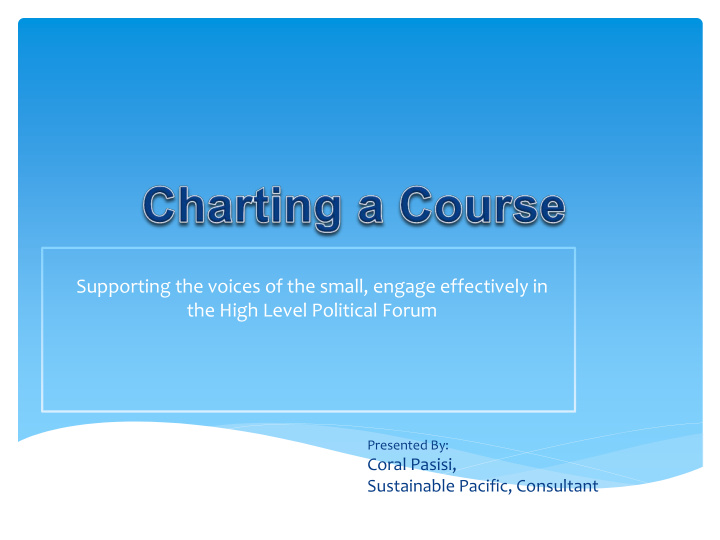



Supporting the voices of the small, engage effectively in the High Level Political Forum Presented By: Coral Pasisi, Sustainable Pacific, Consultant
Who NeedOverview Planning? 1. Full circle of the HLPF 2. Are the right messages getting to the HLPF? 3. National Level arrangements for integrated planning and reporting in Pacific SIDS 4. Regional level arrangements in Pacific SIDS 5. Suggestions
Needs of Individuals & communities High Level National level Political stakeholders Forum and Policies Effective SD Implementation, monitoring and reporting Consolidated Sub-regional Global consensus on Report on positions and Sustainable approaches Development Regional Commissions
Do the right messages reach the HLPF? And come back Chinese whispers? down? HLPF A few representative folks Regional Consensus Sub-Regional Consensus and integrated decision making systems National Integrated Decision Making Systems Individuals articulating a clear message
National Enabling Environment? 1. NSDS or the Like - Key in BPoA, MSI – diverse stakeholder input to planning and reporting – integrated decision making across environ, economic, social. 1. Challenges – limited capacity (numbers), planning without predictability of finance and capacity, juggling sporadic funding allocations and projects; multitude of development partners to manage. 2. National MDG Tracking Reports 1. Challenges – reconciling global targets and units of measure with unique and small environments; lack of data; reconciliation of national and global data sources. 3. Peer Reviews – Strengthening national systems – peer to peer scrutiny, sharing experiences with like minded countries, key donors involved/foster donor harmonisation 1. good example for sharing best practice to strengthen national systems of integrated planning, strong PFM systems, M&E?
Sub-Regional Enabling Environment 1. Existing Sub-regional architecture in Pacific region – fostering regional cooperation and integration - Political, technical, economies of scale. 2. Main sub-regional architecture includes : 1. 9 Intergovernmental Organisations – CROP and its working groups 2. 16 UN Organizations – UNDAF 3. Together, Joint CROP-UN Taskforce 3. Support and report on SD progress across Pacific Island Countries and Territories: 1. Annual Report of Pacific Plan – lessons learned/refining 2. Regional MDG Report – lessons learned and refined 3. Tracking Development Effectiveness – lessons learned 4. State of the Environment Reporting etc
Coordinating sub-regional Architecture PIFS UN RC SPC SPTO SPREP PIDP USP PASO UNICEF PPA UNOCHA FFA ILO UNDP UNFPA UN Agencies 16 ESCAP WHO UN Women CROP Agencies 9
Regional Commission 1. Very large membership - ESCAP 2. Has strengthened sub-regional presence – last 6 years to increase support to PSIDS 3. Still very difficult given distance to Commission meetings – lack of presence of representative missions 4. ESCAP 56 members : Largest and the smallest – small anomalies are drowned out. 5. Need a special reporting process through this to avoid such big dilution of PSIDS issues
Ideas for lining up the Ducks Spotlight on all levels of integrated decision making and show case that at the HLPF e.g. Peer Review – Country level Use existing established IGO arrangements to facilitate rather than create a new layer of reporting and policy development Refine existing regional reporting based on lessons learned from: Regional MDG Reporting; Regional tracking Development Effectiveness; and Pacific Plan Annual Reports. Highlight sub-regional progress and how regionalism has helped to overcome challenges e.g. USP, pooled services, shared experiences of SD Create a special pathway in Regional Commissions for special groupings (e.g. SIDS) so voices remain intact. Simplify resolution language so people understand what this really means and how to engage. Coral Pasisi Director Sustainable Pacific, Consultants. PO Box 79, Alofi, Niue Island (South Pacific) coral.pasisi@icloud.com
Recommend
More recommend